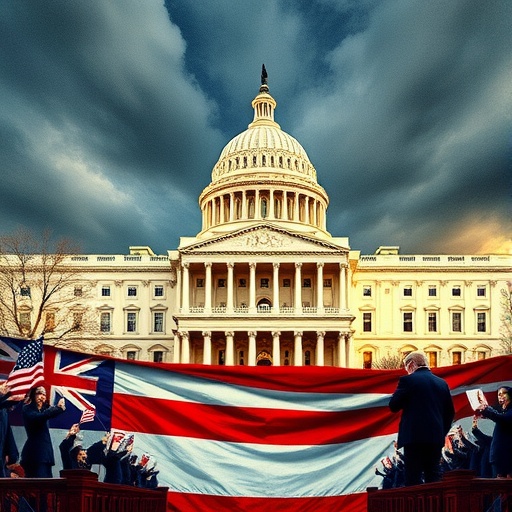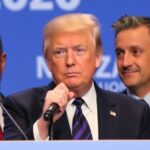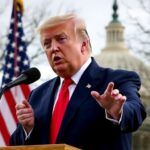Trump Leverages Historic Government shutdown to Boost Presidential Power and Slash Democratic Priorities
In a move that’s reshaping the landscape of American governance, President Donald Trump has transformed the second-longest Government shutdown in U.S. history into a strategic weapon, wielding unprecedented presidential power to furlough thousands of federal employees and redirect federal budget allocations away from Democrats‘ cherished programs. As the shutdown stretches into its 35th day, agencies under Trump’s administration are openly blaming congressional Democrats for the impasse, turning official websites into battlegrounds of political rhetoric.
This crisis, sparked by disputes over border wall funding, has exposed deep fissures in Washington’s power dynamics. With over 800,000 federal workers affected—many working without pay—Trump’s administration has seized the moment to implement sweeping changes, from pausing environmental regulations to reallocating funds for immigration enforcement. Critics argue this isn’t just brinkmanship; it’s a calculated expansion of executive authority that could redefine the balance of power for years to come.
Federal Workers Bear the Brunt of Shutdown Chaos
The human cost of this Government shutdown is staggering, with federal employees across the nation facing unprecedented uncertainty. According to the Office of Personnel Management, approximately 380,000 workers have been furloughed, while another 420,000 are deemed essential and must report to duty without guaranteed paychecks. In Washington, D.C., alone, the economic ripple effects are estimated at $140 million per day in lost wages and productivity, per a report from the U.S. Conference of Mayors.
Take, for instance, the story of Sarah Jenkins, a 45-year-old IRS auditor from Virginia. “I’ve served my country for 18 years, but now I’m dipping into savings just to buy groceries for my kids,” Jenkins shared in an interview with local news outlet WUSA9. Her plight echoes thousands of similar tales: Coast Guard members patrolling treacherous waters without backpay, TSA agents screening passengers amid growing fatigue, and Smithsonian curators watching priceless artifacts gather dust.
Compounding the hardship, the shutdown has led to a backlog of critical services. National parks, once bustling with visitors, are now operating on skeleton crews, resulting in a 20% drop in attendance and millions in lost revenue, as reported by the National Park Service. Food safety inspections by the FDA have slowed, raising concerns about potential health risks from unchecked imports. “This isn’t just about paychecks; it’s about the safety net of our nation fraying at the edges,” said Sen. Chuck Schumer (D-NY) in a floor speech, highlighting how the impasse is eroding public trust in government institutions.
Economists warn that prolonged disruption could shave 0.13 percentage points off U.S. GDP growth in the first quarter of 2019, according to Moody’s Analytics. Small businesses near federal facilities, from Capitol Hill delis to Virginia contractors, are feeling the pinch, with layoffs in the private sector now numbering in the thousands. As the government shutdown drags on, these workers aren’t just statistics—they’re the faces of a policy battle that’s hitting home hard.
Trump’s Executive Maneuvers Reshape Shutdown Strategy
At the heart of this turmoil is President Trump’s aggressive use of presidential power to navigate the government shutdown. Defying traditional norms, Trump has invoked emergency declarations to redirect funds, including a controversial plan to shift $7 billion from the Pentagon’s budget toward border security. This isn’t mere improvisation; it’s a blueprint for executive overreach that legal experts say could set dangerous precedents.
“The President is treating the shutdown as a license to govern by fiat,” remarked constitutional scholar Erwin Chemerinsky in an op-ed for The New York Times. Trump’s team has paused implementation of the Affordable Care Act’s risk adjustment program, affecting health insurers nationwide, and halted reimbursements for the Children’s Health Insurance Program (CHIP) in several states. These actions, justified under shutdown austerity measures, have drawn lawsuits from affected parties, including a coalition of 16 Democratic attorneys general who argue they violate separation of powers.
Inside the White House, advisors like Stephen Miller have been instrumental in crafting this strategy. A leaked memo from the Office of Management and Budget reveals directives to prioritize immigration-related expenditures, even as domestic programs languish. Trump himself took to Twitter on day 30 of the shutdown, declaring, “Democrats in Congress refuse to fund our brave Border Agents—millions of illegal aliens pouring in! Time to build the Wall.” This rhetoric has galvanized his base but alienated moderates, with polls from Quinnipiac showing Trump’s approval rating dipping to 38% amid the crisis.
Historically, shutdowns have been short-lived bargaining chips, but this one—surpassing the 1995-96 record by mere days—marks a new era. Trump’s approach echoes his campaign promises of strongman governance, where presidential power trumps legislative gridlock. Yet, as federal courts begin to scrutinize these moves, questions swirl: Is this expansion of authority temporary, or the harbinger of a more imperial presidency?
Budget Redirections Target Democratic Strongholds
The federal budget is ground zero in Trump’s government shutdown arsenal, with reallocations that systematically undercut Democrats‘ priorities. In a bold stroke, the administration has frozen $1.2 billion in grants for clean energy initiatives under the Department of Energy, redirecting portions toward ICE detention facilities. Environmental groups like the Sierra Club decry this as “ecological sabotage,” estimating that delayed solar projects could cost the U.S. 50,000 green jobs over the next year.
Similarly, funding for the National Institutes of Health (NIH) has been curtailed, stalling 200 ongoing clinical trials, including groundbreaking cancer research. Dr. Francis Collins, NIH director, issued a rare public statement: “Our scientists are working unpaid, but the real loss is to patients waiting for cures.” This hits Democrats hard, as healthcare and environmental protections form the backbone of their platform. In contrast, Trump’s budget shifts have boosted Customs and Border Protection by 15%, funneling $3.6 billion into wall prototypes despite congressional opposition.
A breakdown of the impacted areas reveals stark partisan divides:
- Housing and Urban Development: $4 billion in community block grants paused, affecting low-income housing in blue states like California and New York.
- Education Department: Pell Grant processing halted, delaying aid for 7 million students, many in Democratic-leaning districts.
- Environmental Protection Agency: Enforcement of Clean Water Act rules suspended, benefiting fossil fuel industries aligned with Republican donors.
These maneuvers aren’t accidental; White House budget director Mick Mulvaney has openly stated in Fox News interviews that the shutdown offers a “reset button” for inefficient spending. Democrats, led by House Speaker Nancy Pelosi, counter that this is punitive politics, with Pelosi tweeting, “Trump’s shutdown is starving the programs that lift up working families—all to fund a vanity wall.” As the federal budget battle intensifies, fiscal hawks on both sides warn of a ballooning deficit, now projected to exceed $1 trillion annually if unresolved.
Official Websites Become Propaganda Fronts
In an unprecedented twist, federal agency websites have morphed into mouthpieces for the administration’s narrative, squarely blaming Democrats for the government shutdown‘s woes. The Department of Homeland Security’s homepage now features a banner reading, “Shutdown Caused by Democrats’ Refusal to Secure Our Borders,” complete with infographics tallying “illegal crossings” since the impasse began.
This digital offensive extends to the IRS site, which warns taxpayers of delayed refunds due to “congressional inaction led by Democrats.” Even the National Park Service, typically apolitical, has posted updates attributing closures to “partisan Democrats blocking bipartisan funding.” Cybersecurity experts from the Brookings Institution note that such messaging violates longstanding guidelines on neutral government communications, potentially eroding public faith in official sources.
Public reaction has been swift and polarized. A Pew Research poll indicates that 62% of Republicans believe Democrats are at fault, compared to just 12% of Democrats. Social media amplifies the divide, with #BlameDems trending alongside #EndTheShutdown. Critics, including former White House ethics lawyer Walter Shaub, argue this weaponizes taxpayer-funded platforms: “It’s not governance; it’s propaganda on steroids.”
Amid the online fray, affected citizens are turning to grassroots efforts. Volunteer groups have stepped in to maintain park cleanliness, while crowdfunding campaigns have raised over $2 million for furloughed workers. As agencies’ web presences fuel the fire, the shutdown’s psychological toll—marked by rising anxiety and partisan vitriol—threatens to outlast the financial one.
Path Forward: Negotiations Stall, Long-Term Reforms Loom
As the government shutdown enters uncharted territory, negotiations between Trump and Democrats remain stalled, with both sides digging in. House Democrats passed a series of funding bills excluding wall money, only for Senate Republicans to block them under Trump’s directive. Bipartisan talks, mediated by Vice President Mike Pence, have yielded little, with the latest proposal—a $5.7 billion wall allocation tied to DACA protections—rejected by hardliners on both ends.
Looking ahead, the implications for presidential power are profound. If Trump succeeds in sustaining these budget shifts, future presidents could emulate the tactic, using shutdowns to bypass Congress routinely. Legal challenges, including a Supreme Court case on emergency fund diversions, could clarify boundaries, but experts predict a 6-3 conservative majority might favor executive latitude.
Economically, the Federal Reserve has signaled potential interest rate cuts to offset shutdown damage, while the IMF warns of global ripple effects on U.S. credibility. For Democrats, reclaiming the Senate in 2020 becomes crucial to reining in such tactics. As one anonymous Capitol Hill staffer put it, “This shutdown isn’t ending soon—it’s rewriting the rules of Washington.” With midterms approaching and public frustration mounting, the path to resolution may hinge on electoral pressures, forcing compromise or escalating the crisis further. The nation watches, wondering if this historic standoff will forge a stronger executive or fracture the republic’s foundational checks and balances.








